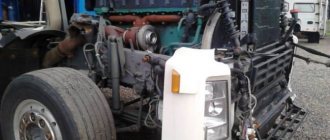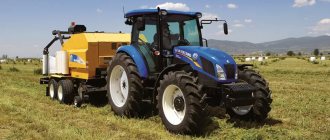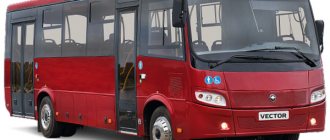In the model range of every automaker there is a flagship with the most powerful engine. The Volvo FH16 can be considered the flagship model not only of VolvoTrucks, but of the entire European truck industry: it is the most powerful production truck on the continent. Having created the Volvo FH16-750, it overtook its closest competitor, Scania, by 30 horsepower. Of course, such a powerful (750 hp) and expensive truck cannot be widespread: carriers do not need such powerful equipment. Unless we are talking about transporting some particularly large construction equipment and indivisible cargo. Ordinary trucks for such a tractor will be just toys. Therefore, in mass production, Volvo FH16 engines have not so monumental engines. Details below.
Currently, the Volvo FH16 is presented on the market in various modifications. These are diesel engines of varying power - from 400 to 750 hp, chassis options - 2 or 3 axles. And the “highlight” of the new generation “Volvo FH16” is the independent front suspension on double wishbones IFS (it will be discussed below, in the corresponding section of the review). However, there are also traditional options, with a transverse beam, which, in turn, are divided into suspensions made on two- or three-leaf springs, as well as on semi-elliptical or pneumatic cylinders.
For transportation on general roads, at normal speeds, modifications with a 4x2 wheel arrangement are usually used as part of a road train. Volvo FH16 truck tractors with a 6x4 wheel arrangement are designed for transportation of large-sized cargo by road trains with a total weight of up to 85 tons. It is possible to order four-axle trucks of this brand to work with even heavier semi-trailers. In this modification, the total weight of the road train can be increased to 100-120 tons.
About the history of the model
VolvoTrucks is a transnational engineering corporation with official representative offices in 140 countries around the world. The main production and design offices are located in Sweden, Belgium, USA, China and Brazil. Volvo truck assembly plants are organized in many countries around the world, including Russia.
Jean Claude Van Damme in the Volvo FH16 advertisement.
Despite its global presence on all continents, the largest share of Volvo truck sales still comes from Western Europe. But even in the United States, despite the presence of serious American competitors, a third of the trucks produced are sold. In Russia, Volvo trucks (flagship FH series, and especially after 2008) are able to be purchased and operated by transport enterprises and individuals only with very good financial capabilities.
In general, the modern model range of VolvoTrucks trucks is represented by the following series: Volvo FL, Volvo FE, Volvo FH. The first production vehicles of the FH family rolled off the company's assembly lines in 1993. Modernizations of the FH series, in accordance with current technical advances and environmental standards, were carried out in 1998, 2001, 2005, 2008, 2012. There was a smooth and systematic evolution of the series, which was successful on the market.
The sixth generation of heavy FH trucks from VolvoTrucks was introduced at the very end of 2012. According to the creators, they sought to build the car in such a way that “everything remains the same as it was in the previous generation, but gets better.”
It was not easy: after 19 years, the structure had practically exhausted all its internal resources. Another tightening of environmental standards in Europe has led to major changes in the layout of components and assemblies, primarily related to the engine cooling system and exhaust gas circulation. This required increasing the space for the engine layout in the front part and in the engine tunnel area.
In order to “insert” the world’s most powerful diesel for a truck into the design of an FH series vehicle, and even use new equipment for Euro-4...5, it was necessary to either reduce the living space of the cabin or sacrifice aerodynamics. Both were unacceptable, and a completely new cabin was developed for the Volvo FH16.
This cabin has a new power frame, different proportions, height and internal volume, which has increased by one cubic meter. The tilt of the pillars is now visually absent, and this has a positive effect on visibility. In addition, the front pillars have become very thin. However, in total, the result was a frame no less rigid than that in the cabin with massive “beams” of the front pillars. There is no doubt about this, because... The issue of ensuring security in Europe is treated more than scrupulously.
By the way, in terms of the use of various additional electronic safety systems, the Volvo FH16 can also be called a record holder (they will be discussed below). This car is the modern embodiment of reliability and safety. And style too: the most thoughtful equipment and rich cabin trim, a strictly maintained exterior of the car, decorated with chrome parts and especially impressive in black with “Mystik Fjord” undertones, claim leadership in the entire segment and in terms of style.
Purpose and scope of application
In a practical sense, this is a vehicle for transporting significant volumes of cargo, intended for large transport companies. In their reliable hands, it is able to demonstrate its high efficiency as efficiently as possible, capable of towing a road train with a total weight from 44 tons to 85 tons (in versions with top-end engines). Naturally, the use of such a large-capacity truck significantly reduces the costs of long-distance transportation of large consignments of cargo. The highly durable frame, made from chrome-molybdenum steel, is backed by a lifetime warranty.
As a truck tractor, this truck works as part of a road train together with various types of vans, refrigerators, tankers, semi-trailers for transporting heavy equipment, and dump platforms too. Various types of equipment applicable in construction, industry, and logging are also installed on the Volvo FH16 chassis. Volvo FH16 vehicles can be made with the following wheel configurations – 4×2; 6x2; 6x4; 8x4.
A powerful diesel engine, combined with modern control and safety systems with sophisticated suspension settings, ensures uniformly fast movement when loaded, even on roads with difficult terrain (beams, descents, ascents), without a significant reduction in speed. And also in any weather, and on roads with poor-quality hard surfaces.
Specifications
The model has a six-by-two wheel arrangement. The total vehicle weight is 44,000 kg. In this case, the permissible load on the rear axle is 26,000 kg, on the front axle – 9,000 kg. Additionally, the Volvo FH 16 can operate with a trailer weighing 9000 kg.
Dimensional characteristics of the model:
- length – 5865 mm;
- width – 2467 mm;
- height – 3200.
The maximum speed of the model is limited to 90 km/h.
Engines
The new Volvo FH16 trucks are equipped with two types of engines – D13C and D16G. These are six-cylinder in-line liquid-cooled diesel engines, with a turbocharger, turbo compound, and intercooler; working volume of 12.8 dm³. Both of these engines comply with Euro-5 environmental standards.
The D13C compression ratio is 17.8:1; "D16G" - 16.8:1. The diameter of the “D13C” cylinder is 131 mm; "D16G" - 144 mm. Each of the above engine models has 2 full-flow and 1 part-flow oil filters. The volume of oil required for replacement, including the filter, is 33 l for the D13C and 42 l for the D16G.
The total volume of the cooling system is: 38 liters for the D13C and 48 liters for the D16G. There are clear requirements for the quality of diesel fuel: the “ULSD” standard (ultra-low sulfur diesel fuel, maximum sulfur content - no more than 10 parts per million). The frequency of engine oil changes is set by the manufacturer as 100,000 km or once a year when using VDS4 oil.
How does turbocompound work?
Turbocompound is a classic recirculation system. It converts and uses energy that previously simply, literally, went down the drain. The “waste energy” is not thrown into the exhaust pipe: a second turbine, which is installed behind the turbocharger and driven by the exhaust gases, takes additional heat from these gases.
The second turbine of the turbo compound rotates at speeds of up to 55 thousand revolutions per minute. This motion energy is transmitted through turbine gears and a hydraulic coupling, and then through the timing gears to the crankshaft. These rotational transmissions create a useful increase in torque, which is reflected in the change in torque at the flywheel. Provides additional traction without significantly increasing diesel fuel consumption.
Both engine variants demonstrate impeccable adaptability to different operating modes. The rotation of the crankshaft is complemented by the constant transmission of forces from the turbo compound. This helps to equalize load pulsations, which are caused by periodic combustion strokes in the cylinders. Thanks to this, the engine runs smoother and smoother, and the effective torque range is significantly expanded.
Volvo Trucks provides consumers with a wide range of engine power options for the Volvo FH16 truck. Both engine options combine different power modes: 540, 600, 700 or 750 horsepower and 2800, 2800, 3150 or 3550 N•m of torque, respectively. This makes it easier to select the power mode required for specific transport applications.
Volvo FH16 engines also feature such design solutions as exhaust gas recirculation, AdBlue injection, and a particulate filter. Volvo FH16 engines have direct fuel injection. Their designs use single cylinder heads and camshafts located on top. The electronically controlled unit injectors provide injection pressures of up to 2400 bar with perfect synchronization thanks to the EMS engine management system.
The closed crankcase ventilation system ensures uninterrupted recirculation of crankcase gases. The rear drive mechanism features a compact and lightweight design, driven by an air compressor - together with the power steering, oil and fuel pumps.
Volvo FH16 trucks can be equipped with steel or aluminum fuel tanks with a capacity range from 150 to 900 liters. The maximum intended volume for the Volvo FH16 truck tractor, when using the main and additional fuel tanks, is 1480 liters. The tank for the AdBlue reagent, with a built-in AdBlue pump, is made of plastic and has a capacity of 32 to 100 liters.
Fuel consumption
The average fuel consumption for a Volvo FN 16 car is 25.2 l/100 km. This is lower than other representatives of this segment (especially domestic ones). The truck's fuel tank holds up to 700 liters of fuel, which allows transportation over long distances without additional refueling.
Chassis
The latest generation tractors are equipped with an independent front suspension on double wishbones with air bags and a rack and pinion steering mechanism. This type of suspension is available for 4x2 and 6x4 trucks with a load capacity of 8.5 tons. However, on most Volvo FH16s, the suspension design uses small-leaf parabolic springs. Depending on the wheel formula, 4, 6, or 8 cylinders are installed on the rear air suspension. The rear axle load for vehicles with a 4x2 wheel arrangement ranges from 11.5 to 13 tons. Wheelbase sizes vary from 3700 to 4600 mm. Front and rear disc brakes. Engine brake VEB+. The tires on all axles are the same as standard. 80 profile tires with a width of 315 mm are used. For Volvo cars, the main tire suppliers are Continental, Bridgestone, and Michelin.
Transmission and axles
Volvo FH16 trucks are available with both a 14-speed manual and a 12-speed I-Shift automatic transmission. These are gearboxes with a divider and range, with two reduction gears, four reverse speeds and automatic shifting. Patented servo-assisted synchronizers ensure effortless shifting. For gearboxes, installation of a compact retarder, power take-off, emergency power steering pump, and oil cooler is provided.
Of course, I-Shift is not a simple manual gearbox. Its secret lies in the electronic control unit. This ECU is responsible for the pneumatic system that controls the clutch and gears. Continuously receiving real-time information about vehicle speed, acceleration, weight, road grades, required torque and other data, it makes every gear change with great precision.
The electronic control unit is connected to the motor, which in turn regulates the speed and enhances the engine braking effect, for consistently fast and comfortable gear changes. The I-Shift system can be equipped with a compact retarder, power take-off, emergency power steering pump and oil cooler.
The I-Shift transmission was designed specifically to save diesel fuel. This is a reduction in internal energy losses - they are indeed lower compared to a manual transmission. This is a gear change carried out in an economical operating mode with great precision, to ensure that the engine operates in the most efficient range of speed. The “I-Roll” function automatically turns off the engine when driving on descents and uses the inertia of the truck to save fuel.
Even greater diesel fuel savings are achieved when using the additional “I-See” option. It saves and systematizes information about the ascents and descents traveled. Based on this data, optimal acceleration and torque will be achieved before each climb, and the higher gear will remain engaged longer. When driving uphill, I-See uses available road terrain information to avoid unnecessary downshifts.
Just before the descent, the power train will temporarily disengage, allowing the Volvo FH16 to coast. This will save energy and minimize the need for braking. But it will be possible to save fuel even on unfamiliar routes. Because the I-See system relies not only on GPS maps, but also takes data from a cloud server. Assuming that the road has been previously driven by a truck, I-See will download the data and provide fuel saving opportunities without delay.
The clutch in the Volvo FH16 can be used as a single- or double-disc pull-out type. Rear axles of this model may vary in design, load, torque and other parameters. The most reliable are the so-called “dump” bridges. They are characterized by a spaced main gear, hub planetary gearboxes, interaxle and interwheel differential locks. The axle design is designed for increased loads and increased torque. For three-satellite axles, gear ratios range from 3.33 to 5.41. For reinforced axles from 3.61 to 7.21.
It is possible to lift the drive axle in a two-axle trolley. You can disable and raise the near rear axle in a two-axle bogie by pressing a button on the dashboard. This raise will help reduce fuel consumption and reduce the turning radius. Protection in case the car is loaded is also provided: then the system will not obey this command, and the bridge will automatically lower and connect.
Trailing rear axles are available in several configurations - fixed with single or double tires, self-steering or with active steering. Axial load is 7.5; 9.5 or 10 tons.
Steering, braking and control
The Volvo FH16 uses dynamic steering with torque overlap. It provides more steering force at low speeds, reduces steering wheel kickback and keeps the steering wheel straight when braking on non-uniform friction surfaces.
The steering wheel automatically returns to its original position both when moving forward and when moving in reverse. Dynamic steering is available for all configurations, including the version with dual front axles. It can also be installed in combination with independent front suspension.
The truck's brake system is pneumatic, electronically controlled, with disc mechanisms and a compact hydraulic retarder (brake force booster). The main braking system is assisted by auxiliary brakes (VEB+ engine brake and EPG special mountain brake). Due to this, the speed of movement can be increased during the trip, without compromising safety. The special “Blending” system will select and apply the appropriate brake option.
Suspension
Volvo FH16 trucks are available in five chassis heights: ultra-low (810 mm), low (850 mm), medium (900 mm), high (1000 mm) and extra high (1200 mm). Wheelbase sizes range from 3700 to 4600 mm.
The front suspension of the truck is independent in the Volvo FH16 variants with 4x2, 6x2 and 6x4 wheel arrangements. This means that each front wheel is suspended separately from the other, on double wishbones with air springs, which contributes to unique handling. For most Volvo FH16s, their suspension design uses small-leaf parabolic springs. Depending on the wheel formula, 4, 6, or 8 cylinders are installed on the rear air suspension.
The car is equipped with an electronically controlled suspension, which provides increased transportation comfort and cargo safety. This electronic control system automatically adjusts the height, keeping the vehicle at a constant level and compensating for possible uneven load distribution. The height of the loading platform is manually adjustable.
Scania R540 Highline
Scania R540 Highline
The Swedish Scania tractor at the end of 2020 won the Green Truck award as the most economical representative of its class. Its average fuel consumption was only 25.14 liters per 100 km at an average speed of 80 km/h. This is not the first such victory for the Scandinavian brand Scania.
Our company offers a MAZ brand tractor, which can be purchased on individual lease terms with warranty and post-warranty service and delivery in Khabarovsk
Low diesel fuel consumption not only reduces owners' expenses, but also causes less harm to the environment.
Help Let us remind you that Green Truck tests are held annually in Germany in September. The tests are organized by the authoritative publications Truck and Verkehrs Rundschau. The tested vehicles must have an engine of no more than 500 horsepower and a road train weight of up to 40 tons. During week-long tests with loads of 32 tons, experts find out which of the machines have the lowest consumption.
The test results showed that the leading positions are occupied by tractors with engines with output up to 450 hp. Their efficiency is higher than that of more powerful competitors.
Device
The Volvo FSH 16 model is equipped with an advanced I-Shift gearbox. It is especially convenient for drivers, as it provides additional efficiency when driving long distances at high speed. The I-Shift “automatic” with additional software can be used to perform specialized tasks. The upgraded I-Roll system allows for significant fuel savings. The Volvo FH 16 also comes with a 14-speed manual transmission, complemented by a divider and range (with or without overdrive). This gearbox creates minimal vibration and noise levels.
For the Volvo FN 16, a huge selection of rear axle types is offered, distinguished by high reliability and low internal power losses. Rear axles equipped with a single-stage gearbox minimize losses on well-paved roads.
The main brake system and auxiliary brakes (VEB+ engine brake and special EPG mountain brake) are responsible for safety on the highway in this model. Due to them, without compromising safety, you can increase the speed of movement. The special Blending system selects the appropriate brake system.
Among the features of the main braking system are:
- emergency braking system (Panic Brake Assistance);
- automatic distribution of braking force;
- electronic stability control system;
- compact retarder that increases braking force;
- pneumatic brake system with electronic control;
- durable brake discs;
- exhaust gas pressure regulator.
The car is equipped with an electronically controlled suspension, which ensures increased transportation comfort and cargo safety. The system adjusts the height automatically, keeping the vehicle at a constant level and compensating for unevenly distributed loads. The height of the loading platform can be adjusted manually. The system can be programmed to different levels if desired. The Volvo FSh 16 is offered in two suspension options: rear-wheel only and all-wheel.
The manufacturer produces the Volvo FH16 with several chassis options:
- high;
- average;
- low.
The truck is also equipped with a large number of assistants and security systems:
- side collision warning system. It monitors blind spots when changing lanes, warning about the presence of a car with a special signal;
- lane departure warning function;
- fatigue warning system that monitors pedal movement and steering wheel position. If the driver deviates from the specified trajectory, an audible signal sounds to warn the driver;
- directional stability function that compensates for driver errors;
- adaptive cruise control that maintains distance.
The Volvo FN 16 is available with several cab options:
- a regular cabin with a berth. It features a slightly curved dashboard for easy viewing of gauges and meters and plenty of storage compartments;
- Globetrotter cab with high height. You can move around inside it completely freely, and the sleeping place can accommodate two people at once;
- Globetrotter XL cab with increased cabin width and height. Extra space and a huge number of storage compartments make it very convenient. The cabin will provide normal rest for two people.
Design
The third generation car received a stylish and modern design. The model is distinguished by smooth aerodynamic shapes, stylish stampings, a massive dark silver matte radiator grille, chrome-plated matte door handles, logo and steps. The color range of the model has also expanded - the Volvo FSH16 is painted in a dark, stylish color.
The truck's headlights are made in the form of irregularly shaped trapezoids. Just below them are daytime running and side lights, with turn signal indicators integrated into them. Optionally, the truck is equipped with powerful fog lights and flashing lights.
Cabin
The Volvo FH16 truck is equipped with four cab options.
- Sleeping cabin (CAB-SLP) with an internal height of 1.71 m, a height along the engine compartment lid of 1.62 m. Equipped with sleeping places for two people.
- Globetrotter cabin (Globetrotter CAB-HSLP) with sleeping places for two people and additional storage space. The internal height is 2.05 m, along the engine compartment lid - 1.96 m.
- The Globetrotter XL CAB-XHSL offers spacious sleeping accommodations for two people, increased height and more storage space. The internal height of this cabin is 2.2 m, along the engine compartment lid - 2.11 m. The glass area in this cabin has been increased by 17 percent.
- Low sleeper cab (CAB-LSLP) with suspension and additional cargo space above the cab. Its internal height is 1.47 m, along the engine compartment lid - 1.38 m.
The Volvo FH16 cabin is equipped with a four-point suspension; can be equipped with fully damped coil springs, coil springs at the front and air suspension at the rear, or full air suspension. The Volvo FH16 cabin is equipped with several style solutions: vinyl, textile, soft textile, leather, textile/leather and two-tone leather. Leather seats can be ordered with a ventilation function.
In the basic configuration, the driver's seat is equipped with a headrest, an adjustable and reclining backrest, an adjustment device in the vertical and longitudinal directions, an adjustable lumbar support and an angular adjustment system. The driver's seat is available in "Basic", "Comfort" or "Luxury" versions, with a corresponding choice of upholstery. The total range of seat adjustment is: forward-backward – 240 mm; vertical adjustment – 100 mm. The passenger seat has a “Standard” or “Comfort” level, also with a choice of different upholstery. A headrest is included as standard. The passenger seat can be sliding and swiveling.
The model is equipped with a comfortable and stylish interior. The shape of the seats is designed in such a way that the driver and passenger feel maximum comfort while in the cabin of the truck. The lateral support system, as well as high-quality premium materials, only enhance this effect. The seats can be trimmed in leather or have a combination of fabric and leather. These chairs are available exclusively on this model.
The car's steering wheel is made of dark-colored leather and looks organically combined with the rest of the interior elements. The steering wheel is adjustable in height, reach and angle, in addition, it can be moved back, which allows larger drivers to comfortably exit the Volvo FH16 cab. The center console and panels have rounded corners, which increases the passive safety of the driver and passengers. The controls are located close to the driver's seat. The instrument panel indicators are easy to read, and the on-board computer supports the Russian language.
For long journeys, there is a comfortable sleeping place, and a large number of shelves and niches for storing personal belongings of the driver and passenger. Under the berth there are standard refrigerators for storing food. In the cold season, a standard autonomous heater is used.
The third generation Volvo FSH16 is standardly equipped with a full-fledged multimedia system, thanks to which the driver will not get bored on the road or during a break.
Fuel consumption fsh 12 420 Volvo, repair instructions, video
Category: All about repairs
Vehicle characteristics: The dimensions of the car are as follows: length - 3588, width - 1100, height - 1677 mm. The wheelbase is 2480 mm. Ground clearance 167 mm. The car is equipped with a hybrid power unit. The 2-cylinder engine is equipped with a system that provides engine power output. There are 4 valves per cylinder. The diameter of one cylinder is 75 mm, the piston stroke is 76 mm. The engine crankshaft accelerates to 2000 rpm. Maximum torque is maintained up to 3000 rpm.
Posted by admin: at the request of Aquilius
Views: 2480
Watch the VIDEO about the fuel consumption of Volvo fsh 12 420.
Reasoning from a car owner named Osman: 1) Very good driver visibility, good side mirrors, essentially no blind spots 2) Excellent handling, holds the road well, even in not very favorable weather and in sharp turns. The roll in corners is also insignificant, I think it’s quite difficult to tumble this car 3) Excellent performance of the climate control, completely fogged windows blow up in 30 seconds, and when the climate control is working, the windows do not fog up at all 4) The rear seats fold into a flat floor, and if necessary, you can fold half of the rear sofa5 ) Normal fuel consumption for a crossover, so far the best result is 7.5 liters per hundred on a night highway when driving long distances using cruise control, while the car was filled to capacity with people and cargo, and on average it eats about 9-10 on the highway and 12-13 around the city (with traffic jams of course). (Diesel drivers, please do not be nervous, gasoline companies overpay for fuel, and you initially pay for the engine, and which is more profitable depends on the intensity of use and luck)6) Quite clear rain and light sensors, the work is quite correct (for the most part I have already forgotten what on/off is headlights and wipers)7) Very comfortable and spacious interior, even for large and tall people. Quite ergonomic front seats and the presence of a flat floor in the back allow five adults to ride comfortably8) Relatively low maintenance costs9) Low loss of value upon subsequent resale of the car10) Quiet engine operation
Original name: ??????? ?????? FSH 12 420 ?????
Release date: December 17, 2016
Duration: 13:43
Quality: VHSRip
Laughter on topic: My friends once caught a parrot. They didn’t even catch it, but suddenly they saw it on a branch outside the window. They opened the window, my husband even brought a cage from the mezzanine - once upon a time a canary lived with them until it died. They waved the cage, their hands, and sprinkled something on the windowsill. The parrot was tempted and flew away. He walks along the windowsill, so important. His wife rammed a nut for him, he took the nut and clicked it. “What’s your name, Popka?” – the wife asked. “Suck your pussy,” the parrot answered affectionately, tilting its head to the side. Then it flapped its wings and flew away.
Video instructions: fuel consumption fsh 12 420 Volvo
femx.ru
Features of operation with additional security systems
Both Volvo cars and trucks have always been positioned as being maximally “armed” with a variety of safety systems. Of course, the brand’s flagship model is equipped with such “helpers” to the maximum.
For safety reasons, Volvo FH16 cabs are equipped with glass roofs, which can be used as an escape hatch in the event of a rollover. All elements of the cabin: steering wheel, instrument panel, trim - are made of energy-absorbing materials. The seat upholstery has fire-resistant properties. In a number of cases, active safety systems with electronic sensors and cameras will automatically prevent collisions or warn the driver of danger:
- LKS (Line Keeping Support) – will notify you about deviation from the lane;
- DAS (Driver Alert Support) - monitors the position of the steering wheel, the degree of influence on the pedals and the position of the car relative to road markings. An audible signal and a light indicator will warn about the beginning of a deviation from the direction and wake up the driver;
- ACC (Adaptive Cruise Control) – adaptive cruise control will maintain a safe distance in traffic;
- ESP - the exchange rate stability system will automatically redistribute the braking force on slippery roads or when cornering at high speed, preventing a dangerous roll that threatens to tip over the car.
- Special cornering lighting system. Immediately after turning on the turn signal, an additional side headlight lights up, which illuminates the space in the direction of the turn and visually expands visibility, which is especially important in bad weather conditions.
- The corresponding system (EBS) will help you move uphill.
- The Alcolock electronic lock (additional option) will not allow a drunk driver to drive.
- In any fire (literally) case, the automatic fire extinguishing system of the engine compartment will work.
Such solid equipment is designed to compensate as much as possible for all possible mistakes and miscalculations of the driver, the notorious “human factor”. Hydraulic power steering can be supplemented with optional electric power assisted active steering at an additional cost. Other interesting and necessary options (already in the database) include an electronically controlled brake center with a choice of disc or drum mechanisms; electric windows, digital tachograph, heated driver's seat, modern audio system, air conditioning, electrically heated and electrically adjustable exterior mirrors.
And yet, completely from the realm of recent science fiction. Using the new wireless communication technology introduced on the flagship Volvo Trucks series, it is possible to constantly monitor the wear of key components, and the overall condition of the vehicle too. According to the creators of this system, service center engineers will be able to remotely check the current “health” of various components and the Volvo FH16 car from their computer. If a part begins to wear out, service center specialists can contact the transport company in advance; agree on a date for maintenance; order and prepare a new part to replace the worn one. Whether this system will take root and whether it will be able to work effectively in the CIS is still unknown.
Modifications
The third generation machines have several modifications. First of all, the model is distinguished by the type of cabin installed:
- Volvo FH16 Globetrotter XL. The highest and most spacious cabin. Equipped with two sleeping places;
- Globetrotter. A cabin with increased dimensions and two berths;
- Standard cab. It is equipped with one sleeping place and has a relatively low height.
In addition, the truck is distinguished by the typical dimensions of the cargo chassis:
- Very low – 810 millimeters;
- Low – 850 millimeters;
- Average – 900 millimeters;
- High – 1000 millimeters.
Depending on the chassis of the car, the purpose of the car is also chosen. For example, an ultra-low chassis is typical for truck tractors.
Renault Premium
Renault Premium
The line of tractors of the French brand is presented in several modifications, and offers owners a full-fledged driver's berth for long trips and a number of interesting technical solutions, for example, the truck doors can be opened 90 degrees.
This is interesting: an up-to-date review with a rating of the largest tractors in the world with photos, technical characteristics and detailed information
Renault Premium is characterized by the presence of several V6 diesel options with a maximum power of up to 440 horsepower. Due to the presence of an electronic controller of operating parameters, the road train when loaded does not consume more than 35 liters per 100 km, regardless of the driving mode.
The basic one is a manual transmission with 16 ranges, but some configurations are available to the buyer with an automatic transmission. The suspension is traditional, with springs for the front axle and pneumatics for the rear wheelset. Disc brakes with ABS provide shorter braking distances in an emergency.










